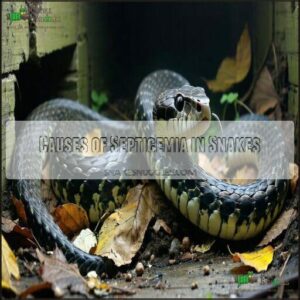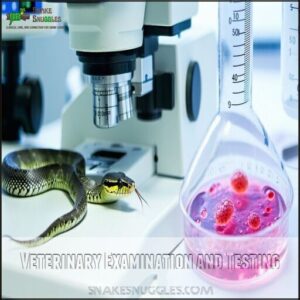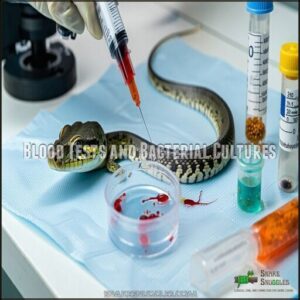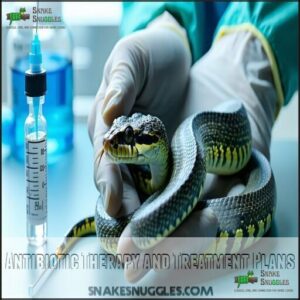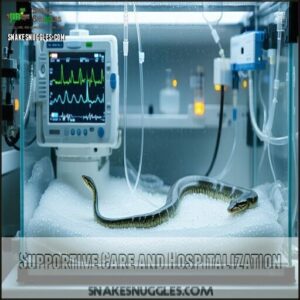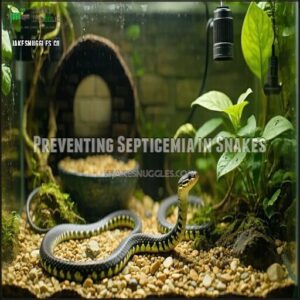This site is supported by our readers. We may earn a commission, at no cost to you, if you purchase through links.
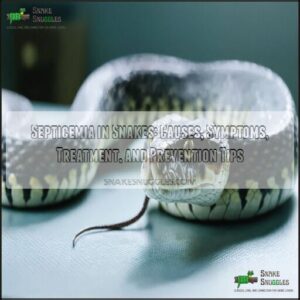 Septicemia in snakes occurs when bacteria enter the bloodstream, causing a potentially fatal infection. You’ll notice symptoms like lethargy, discolored scales, and loss of appetite.
Septicemia in snakes occurs when bacteria enter the bloodstream, causing a potentially fatal infection. You’ll notice symptoms like lethargy, discolored scales, and loss of appetite.
Your snake might show respiratory distress or unusual positioning. This condition requires immediate veterinary care, typically involving antibiotics and supportive treatments.
To prevent septicemia, maintain clean enclosures, promptly treat wounds, and schedule regular check-ups. Poor husbandry, untreated injuries, and stress substantially increase risks.
Temperature regulation plays a vital role in your snake’s immune function. Understanding the early warning signs could make the difference between recovery and serious complications, and requires immediate veterinary care for potentially fatal infection with supportive treatments.
Table Of Contents
- Key Takeaways
- Causes of Septicemia in Snakes
- Recognizing Symptoms of Septicemia
- Diagnosing and Treating Septicemia
- Preventing Septicemia in Snakes
- Managing Septicemia Complications
- Frequently Asked Questions (FAQs)
- Do snakes have septicemia?
- What is septicemia?
- How do you treat a snake septicemia?
- What causes septicemia in reptiles?
- What are the symptoms of septicemia in reptiles?
- Do pythons have septicemia?
- How does a snake get septicemia?
- How to treat sepsis in snakes?
- What are the early warning signs of septicemia?
- How do you treat septicemia in a snake?
- Conclusion
Key Takeaways
- You’ll need to act quickly if you notice septicemia symptoms in your snake, including lethargy, discolored scales, respiratory distress, and loss of appetite, as this bloodstream infection can be fatal without immediate veterinary intervention.
- Maintain a clean enclosure by removing waste daily, regularly changing substrate, and disinfecting the habitat monthly to prevent bacteria from entering your snake’s bloodstream through wounds or infections.
- Reduce stress in your snake’s environment by providing adequate space, proper hiding places, and limited handling, as stress weakens their immune system and increases vulnerability to septicemia.
- Treat any wounds or injuries promptly with proper cleaning and vet-approved disinfectants to prevent bacteria from entering the bloodstream, and always quarantine new snakes for 30-60 days before introducing them to your snake collection.
Causes of Septicemia in Snakes
Septicemia in snakes happens when harmful bacteria enter the bloodstream through wounds, infections, or poor living conditions.
Factors like untreated injuries, parasite infestations, and stress weaken their immune system, making them more vulnerable to septicemia.
Bacterial Infection Routes
Bacteria are opportunistic invaders, exploiting various pathways to trigger snake septicemia. Understanding these routes is essential to protect your snake from a potentially fatal bacterial infection.
Here are the primary ways bacteria enter a snake’s system:
- Wound Contamination – Even tiny snake wounds or scratches become entry points for harmful bacteria, leading to systemic spread.
- Environmental Bacteria – Dirty substrates, water bowls, or unclean enclosures harbor pathogens that can infect your snake.
- Oral Transmission – Feeding contaminated prey introduces bacteria directly into the digestive system, increasing infection risk.
Parasite vectors can also carry bacteria, compounding the threat. Early signs, like reddish patches on belly scales, often go unnoticed until the infection progresses. Owners frequently say, “It seemed like a small scrape,” only to face severe consequences later.
Maintaining proper enclosure hygiene is vital in preventing bacterial infections. Prioritize hygiene and clean living conditions to reduce exposure and safeguard against snake bacterial infections.
Traumatic Injuries and Bacterial Entry
Trauma opens doors for snake bacterial infection, turning wounds into gateways for septicemia.
Whether it’s prey injuries, bite risks, surgical infections, or scale damage, bacterial entry can escalate fast.
| Injury Type | Risk Level | Signs to Watch | Treatment | Prevention |
|---|---|---|---|---|
| Prey Injuries | Moderate | Swelling, redness | Clean with antiseptic | Use pre-killed prey |
| Bite Wounds | High | Discharge, swelling | Immediate vet care | Monitor interactions |
| Surgical Infections | High | Redness, discharge | Antibiotics | Post-op hygiene |
| Scale Damage | Moderate | Skin discoloration | Clean, monitor | Proper enclosure setup |
| Untreated Minor Cuts | High | Red patches | Antiseptic, vet care | Inspect snake regularly |
Prompt care prevents snake septicemia from spiraling.
Untreated Infections and Infestations
Leaving infections untreated can quickly turn a manageable issue into a life-threatening case of snake septicemia.
Parasite overload, like mites or ticks, creates tiny wounds that bacteria exploit, leading to systemic infections. Wound neglect, even with minor injuries, gives bacteria a direct path to the bloodstream.
Parasites open invisible doorways for bacteria, while ignored wounds become superhighways to the bloodstream.
- Scale rot from damp, dirty conditions, allowing bacteria to thrive.
- Abscess risks when infections fester under the skin.
- Oral infections from injuries during feeding or poor hygiene.
Snake infection signs, such as lethargy or skin discoloration, often appear late, making early action essential. Treat infestations and wounds promptly with proper care or snake antibiotics. Ignoring these issues risks severe bacterial infection and, ultimately, your snake’s survival.
Poor Living Conditions and Hygiene
Your snake’s environment plays a huge role in preventing snake septicemia. A dirty enclosure isn’t just unpleasant—it’s a breeding ground for harmful bacteria.
Poor enclosure sanitation, like waste buildup or moldy substrate choices, invites infections. That murky water dish? It’s a hotspot for disease.
Regular snake enclosure cleaning and maintaining proper hygiene protocols are non-negotiable. Replace soiled bedding, clean water bowls daily, and monitor water quality.
A clean habitat supports your snake’s health, while neglecting snake hygiene risks dangerous infections that could turn deadly. Maintaining a clean enclosure may require specialized cleaning products.
Stress and Immune System Suppression
Even with a clean enclosure, stress can weaken your snake’s immune system, paving the way for septicemia.
Stress hormones disrupt their ability to fight infections, while poor nutrition worsens immune weakening. Environmental factors like overcrowding and improper handling amplify these risks.
Watch for stress signals:
- Refusing meals or erratic feeding habits
- Excessive hiding or defensive behavior
- Overreacting to your presence
Quarantine stress in new snakes can also trigger immune suppression. Reducing stress impact is essential to keeping your snake healthy and septicemia-free.
Recognizing Symptoms of Septicemia
Spotting septicemia early in your snake can make all the difference in its recovery.
Look for signs like lethargy, breathing problems, skin discoloration, and changes in appetite to catch this serious condition before it worsens.
Early Warning Signs and Lethargy
Subtle lethargy is often the first clue of snake septicemia. Your snake may seem unusually inactive, hiding more and showing less curiosity. It’s easy to confuse this with normal behavior shifts, but it’s a sign to watch closely.
Appetite loss, delayed reactions, and odd resting positions can also appear, hinting at deeper issues.
| Symptom | Description | Action Needed | Urgency Level |
|---|---|---|---|
| Subtle Lethargy | Reduced activity, hiding more | Monitor closely | Moderate |
| Appetite Loss | Refusal to eat | Seek veterinary care | High |
| Delayed Reactions | Slow or unusual movements | Immediate attention | Critical |
| Behavior Shifts | Unusual positions or hiding habits | Emergency vet visit | Critical |
Quick response guarantees better outcomes for septicemia symptoms in snakes.
Respiratory Distress and Breathing Issues
When septicemia symptoms in snakes progress, respiratory distress often follows, signaling serious complications.
Breathing becomes labored as bacteria affect the lungs and bloodstream, leading to inflammation and reduced oxygen levels.
Look for these signs of respiratory distress:
- Breathing sounds like wheezing or gasping
- Open-mouth breathing or rapid breathing rate
- Bubbling or discharge near the nostrils
These symptoms suggest lung damage and possible airway obstruction, worsening as the infection spreads.
Without treatment, oxygen therapy may be required to stabilize your snake. Don’t ignore these changes—respiratory distress in snake septicemia is life-threatening.
Early intervention can prevent further damage and give your pet a fighting chance. Seek veterinary care immediately.
Discolored Patches and Skin Lesions
Red blotches or swollen areas on the underside often signal snake septicemia symptoms.
Discolored scales, blister disease, and ulcerative dermatitis are key signs. Skin necrosis or hemorrhagic patches may appear as infections progress.
These snake skin lesions aren’t shedding-related—they’re red flags needing urgent care.
| Symptom | Appearance |
|---|---|
| Scale Discoloration | Faded or patchy areas |
| Blister Disease | Fluid-filled bumps |
| Hemorrhagic Patches | Red, swollen spots |
| Ulcerative Dermatitis | Eroded skin lesions |
| Skin Necrosis | Dead, blackened tissue |
Changes in Feeding Habits and Appetite
A snake’s feeding habits can often hint at underlying health problems like septicemia.
Keep an eye out for these dietary changes:
- Appetite Loss – Refusal to eat, even favorite prey.
- Regurgitation Signs – Vomiting after meals.
- Snake Anorexia Causes – Rapid weight loss despite feeding attempts.
- Force-Feeding Risks – Irregular feeding paired with lethargy.
These changes signal serious issues.
Prompt action guarantees your snake gets the care it needs to recover.
Diagnosing and Treating Septicemia
To diagnose septicemia in your snake, veterinarians rely on physical exams, blood tests, and imaging to pinpoint the infection and assess internal damage.
Treatment typically involves antibiotics, supportive care, and sometimes hospitalization to stabilize your snake and prevent further complications.
Veterinary Examination and Testing
Spotting early symptoms like lethargy or red patches is only the start. A thorough physical exam helps your vet assess respiratory distress, skin discoloration, or unusual behavior. Limpness, pale gums, or inflamed scales often signal trouble.
From there, imaging modalities such as X-rays or ultrasounds come into play. These tools reveal internal damage, like organ swelling or abscesses, that mightn’t be obvious.
A CBC interpretation (complete blood count) checks for elevated white cells, while organ function tests assess kidney or liver health. For precision, a snake blood culture identifies the exact bacteria causing the infection.
These veterinary diagnostics guarantee an accurate septicemia diagnosis in snakes, guiding effective treatment.
Blood Tests and Bacterial Cultures
Blood tests and bacterial cultures are your go-to tools for a precise snake septicemia diagnosis. A vet collects a sample for a snake blood culture, placing it in media to grow and identify bacteria.
This bacterial identification helps determine the right antibiotics while addressing potential antibiotic resistance. Though culture sensitivity testing is thorough, interpretation challenges like false negatives mean results must be reviewed carefully.
Longitudinal monitoring through repeated reptile blood tests guarantees accuracy. Notably, even healthy snakes may have bacteria in their blood, so context matters.
Accurate testing gives your snake the best shot at recovery with targeted care and treatment. Septicemia in reptiles can be caused by Aeromonas and Pseudomonas species.
Imaging Techniques and Internal Examination
How do you uncover hidden threats when dealing with septicemia in snakes?
Imaging techniques can reveal internal damage and pinpoint issues that other tests might miss.
Vets often turn to advanced tools to assess organs and diagnose bloodstream infections:
- X-ray analysis: Detects fluid buildup, inflammation, or bone changes.
- Ultrasound findings: Displays blood flow issues and organ assessment details.
- Endoscopy: Offers clear views of internal lesions, lungs, or veins.
- Biopsy guidance: Locates infected tissue for diagnosis.
- Post-mortem exams: Confirms the infection’s extent if untreated.
These methods guarantee accurate diagnosis while carefully considering restraint for aggressive snakes.
Antibiotic Therapy and Treatment Plans
Accurate antibiotic therapy is a cornerstone of septicemia treatment in snakes.
After pinpointing the bacteria through cultures, your vet will choose antibiotics that target the infection efficiently.
Common options include amikacin, ceftazidime, or enrofloxacin.
Dosage strategies are carefully calculated based on your snake’s weight and health to avoid toxicity or underdosing.
Always follow the vet’s instructions.
Stick to the full treatment duration, usually 2–4 weeks.
Stopping early can lead to antibiotic resistance, making future snake veterinary treatment more complicated.
Resistance monitoring involves tracking your snake’s progress and sharing updates so medication adjustments can be made.
Supportive therapies, like keeping your snake hydrated and warm, boost recovery.
By following proper snake antibiotic treatment plans, you give your pet the best chance at overcoming septicemia.
Timely care paired with precise antibiotic selection saves lives.
Supportive Care and Hospitalization
Hospitalization offers snakes with septicemia the best chance at recovery.
Supportive care focuses on rehydration through fluid therapy, ensuring proper hydration without overloading their system.
Nutritional support may involve gentle force-feeding or specialized diets to restore strength.
Here’s what happens during intensive care:
- Environmental control: Stable temperatures and a clean setup promote healing.
- Monitoring techniques: Vets track progress, ensuring antibiotics work effectively.
- Isolation protocols: Prevents spreading infections to other reptiles.
Snake veterinary care during septicemia treatment is precise, giving your pet the attention it needs.
Preventing Septicemia in Snakes
Preventing septicemia in snakes starts with maintaining a clean, stress-free environment that supports their health.
By addressing injuries promptly and ensuring proper care, you can greatly reduce the risk of this serious infection.
Maintaining Clean and Hygienic Environments
Keeping your snake’s enclosure spotless is one of the best ways to prevent septicemia. Start by focusing on Enclosure Sanitation—remove waste daily and clean water bowls to maintain Water Quality. Dirty environments quickly become breeding grounds for harmful bacteria.
Use appropriate Substrate Choices and replace them weekly, ensuring they’re dry and clean. Follow monthly Disinfection Protocols using reptile-safe products to sanitize the entire enclosure. For ideal hygiene, consider specialized products for cleaning enclosures.
Here’s a quick reference:
| Task | Frequency | Purpose |
|---|---|---|
| Waste Removal | Daily | Prevents bacterial buildup |
| Water Bowl Cleaning | Daily | Maintains hydration, hygiene |
| Substrate Change | Weekly | Reduces bacteria, moisture |
| Enclosure Cleaning | Monthly | Eliminates hidden contaminants |
Remember, a clean environment isn’t just for looks—it’s your snake’s first line of defense against infections.
Reducing Stress and Providing Adequate Space
A stress-free snake starts with a well-designed enclosure. Focus on enclosure size—snakes need room to stretch and explore. Include hiding places for privacy and security.
To manage snake stress, follow these tips:
- Limit handling frequency to reduce unnecessary interaction.
- Add environmental enrichment like climbing branches or textured surfaces.
- Avoid social housing unless species-specific behavior supports it.
Proper snake enclosure management reduces stress, improving health and lowering the risk of conditions like septicemia in snakes.
Regular Monitoring and Veterinary Check-Ups
Spotting problems early is key to protecting your snake from septicemia. Regular monitoring and veterinary care act as your best defense.
Regular check-ups and early action are the strongest shields against life-threatening septicemia in snakes. Stay vigilant, act fast.
A snake veterinary consultation isn’t just for emergencies—it’s a proactive measure to guarantee long-term health. Preventative care, like routine health assessments, helps catch hidden issues before they escalate. Considering that infectious stomatitis can be a precursor to more serious conditions, it’s vital to understand snake infectious diseases and their early signs.
Here’s how to stay on top of snake health:
- Weigh your snake monthly to monitor growth and detect sudden weight loss.
- Schedule biannual vet visits for expert consultations and blood tests to uncover early signs of septicemia.
- Track daily habits, including feeding, shedding, and activity, to notice changes quickly.
- Conduct parasite screenings every three months to prevent infections that could compromise immunity.
Proactive measures guarantee your snake stays healthy and thriving.
Proper Wound Care and Injury Management
In the case of snake injuries, quick and careful action can save your pet from serious complications like septicemia. Even minor wounds, if ignored, can lead to infections that spread rapidly.
Start by cleaning the injury with sterile saline to flush out debris. Follow this with vet-approved topical treatments to disinfect the area and reduce bacterial risks. Consistent wound disinfection is key to preventing infections. For readily available options, consider purchasing a solution designed for pets.
Monitor the wound daily for signs of trouble, such as redness, swelling, or discharge. These can indicate an infection brewing. Handle your snake gently during treatment to avoid causing scale damage or stress.
- Use clean, sterilized tools for snake wound care.
- Keep the enclosure spotless to reduce bacterial exposure.
- Avoid feeding live prey to minimize bite prevention concerns.
- Seek professional help if the injury worsens or doesn’t heal.
Snake wound treatment takes patience and vigilance. Proper care guarantees minor injuries don’t escalate into life-threatening conditions requiring septicemia treatment snakes dread.
Quarantine and Isolation Procedures
New snakes or those showing illness need quarantine procedures to prevent septicemia.
Keep them in isolation for a quarantine length of 30–60 days.
Use a separate enclosure with proper ventilation and temperature control to reduce stress.
Hygiene protocols are key—sanitize tools, hands, and surfaces after every interaction.
Daily monitoring frequency guarantees you catch any signs of infection early.
Think of isolation as a protective barrier, safeguarding your healthy snakes while giving newcomers time to adjust.
Infection control starts here, with clean setups and consistent care.
It’s not just precaution—it’s your frontline defense against dangerous bacterial spread in snakes.
Managing Septicemia Complications
Managing complications from septicemia in snakes requires careful attention to organ function and secondary infections.
You’ll need to work closely with a veterinarian to address long-term effects and make decisions about supportive care or, in severe cases, humane euthanasia.
Organ System Failure and Support
When septicemia turns severe in snakes, organ failure can threaten life.
To stay ahead, focus on targeted support:
- Kidney Support: Administer fluids to flush toxins and reduce kidney strain. Hydration is key to maintaining function.
- Respiratory Failure: Oxygen therapy or nebulizers can improve breathing and counteract septic shock effects.
- Cardiac Complications: Stabilize the heart with vasopressors to maintain blood flow and pressure.
Act quickly—addressing these issues early gives your snake’s organs a chance to recover from septic shock.
Secondary Infections and Co-Infections
When a snake’s immune system falters during septicemia, complications like secondary infections and co-infections can worsen recovery.
These include fungal infections, bacterial overgrowth, viral complications, or parasitic overload. Each makes the fight harder, with bacterial toxins overwhelming the body.
Immune suppression leaves your snake vulnerable. Persistent skin lesions, labored breathing, or appetite loss aren’t just septicemia symptoms in snakes—they might flag deeper issues. Some pathogens resist antibiotics, creating more hurdles.
Secondary infections thrive in wounds or stressed areas, turning simple injuries into breeding grounds for harmful microbes. If your snake shows unusual behaviors or worsening septicemia symptoms, consult a vet immediately. Together, you can manage these reptile infections effectively, ensuring no co-infection derails your snake’s chance at recovery. Regular check-ups matter.
Long-Term Consequences and Prognosis
Beyond treating the infection itself, snake septicemia creates lasting health challenges. The prognosis remains guarded to poor in many cases.
Long-term consequences include:
- Significant neurological impairment that may persist in surviving snakes
- Cytotoxic tissue destruction potentially requiring skin grafting in severe cases
- Secondary organ failure particularly affecting liver and kidneys
Continued antibiotic therapy often proves beneficial during recovery. Regular veterinary monitoring helps track organ function and prevent recurrence.
A clean environment is essential for preventing further infection. Maintaining ideal basking temperatures supports healing by aiding proper thermoregulation, improving your snake’s quality of life and recovery timeline.
Euthanasia and End-of-Life Care
When treatment options fail and advanced septicemia causes irreversible damage, you may face difficult decisions about your snake’s future.
Consider euthanasia when your pet shows persistent pain, inability to feed, or severe respiratory distress. Veterinarians can administer humane methods using proper sedation followed by euthanasia solution.
Before making this decision, explore palliative care options like pain management and supportive fluids. Ethical considerations should prioritize quality of life over prolonging suffering.
Remember that grief support is available through reptile communities. This final act of compassion honors your bond while ensuring your snake’s dignity.
Frequently Asked Questions (FAQs)
Do snakes have septicemia?
Yes, your snake can develop septicemia, a serious bacterial infection affecting their bloodstream.
It occurs when bacteria enter through wounds or spread from localized infections, potentially becoming life-threatening without prompt veterinary care, which is a serious condition.
What is septicemia?
Septicemia is a life-threatening condition where bacteria invade your bloodstream, rapidly multiplying and releasing toxins that damage organs.
It’s basically blood poisoning that can lead to organ failure if not treated promptly.
How do you treat a snake septicemia?
You’ll need a vet to administer antibiotics by injection or oral rinse, plus supportive care including fluid therapy.
In severe cases, hospitalization might be required.
Treat immediately for the best chance of recovery.
What causes septicemia in reptiles?
Bacteria enter your reptile’s bloodstream through wounds, untreated infections, or dirty environments.
Poor husbandry conditions, stress, weakened immune systems, and parasitic infestations substantially increase the risk of developing this life-threatening condition.
What are the symptoms of septicemia in reptiles?
When your snake shows lethargy and stops eating, you’ll notice red patches on its belly scales.
You’ll also see breathing difficulties, weakness, convulsions, and skin discoloration.
Prompt veterinary care is essential for survival.
Do pythons have septicemia?
Yes, pythons can develop septicemia like any other snake species.
You’ll notice symptoms including lethargy, red belly patches, breathing difficulties, and appetite loss if your python contracts this serious bloodstream infection.
How does a snake get septicemia?
Nearly 50% of reptile infections escalate to septicemia. Your snake can develop this condition through untreated wounds, dirty environments, parasites, stress, or localized infections that spread bacteria into the bloodstream.
How to treat sepsis in snakes?
Treating sepsis requires immediate veterinary care.
You’ll need to administer prescribed antibiotics, maintain proper hydration through fluid therapy.
Provide supportive care including correct temperature and humidity levels while monitoring your snake closely.
What are the early warning signs of septicemia?
Like a storm brewing on the horizon, watch for lethargy, loss of appetite, respiratory distress, unusual behavior, skin discoloration, and red patches on the belly scales.
You’ll need immediate veterinary attention when these appear.
How do you treat septicemia in a snake?
Immediate veterinary care is essential.
Your vet will administer antibiotics through injection or oral delivery.
You’ll need to provide supportive care including fluid therapy, maintain proper enclosure conditions, and possibly assist with force-feeding.
Conclusion
Like a vigilant guardian watching for the first signs of danger, recognizing septicemia in snakes early can save your pet’s life.
By maintaining clean enclosures, monitoring for symptoms, and seeking immediate veterinary care when problems arise, you’ll substantially reduce the risk of this potentially fatal condition.
Remember that proper temperature regulation supports immune function, and regular check-ups can catch issues before they become serious.
Septicemia in snakes requires swift action—your attentiveness is their best defense.
- https://arav.org/salmonella-reptiles-veterinary-guidelines
- https://www.vetlexicon.com/exotis/reptiles/microbiology/articles/septicemic-cutaneous-ulcerative-disease/
- https://bioone.org/journalArticle/Download?urlId=10.5818%2F1529-9651-27.1-2.44
- https://www.cabidigitallibrary.org/doi/pdf/10.5555/20073120019
- https://www.merckvetmanual.com/exotic-and-laboratory-animals/reptiles/bacterial-diseases-of-reptiles

